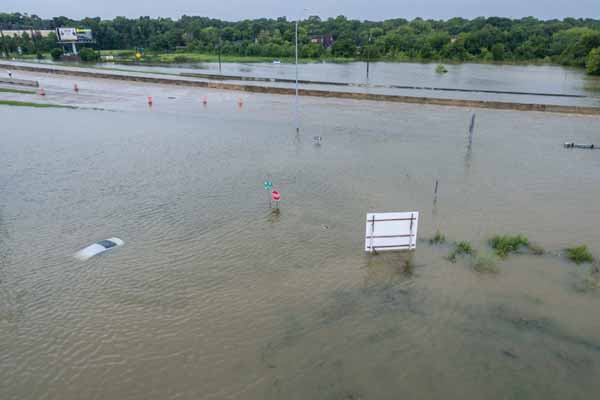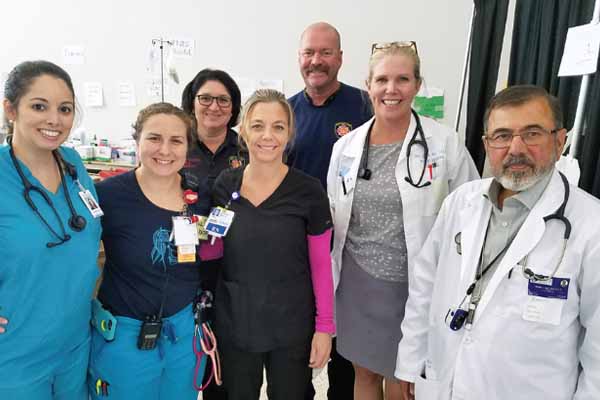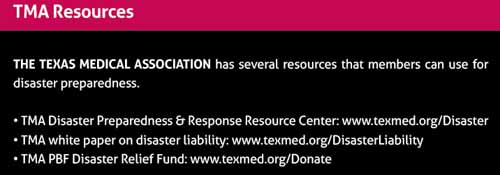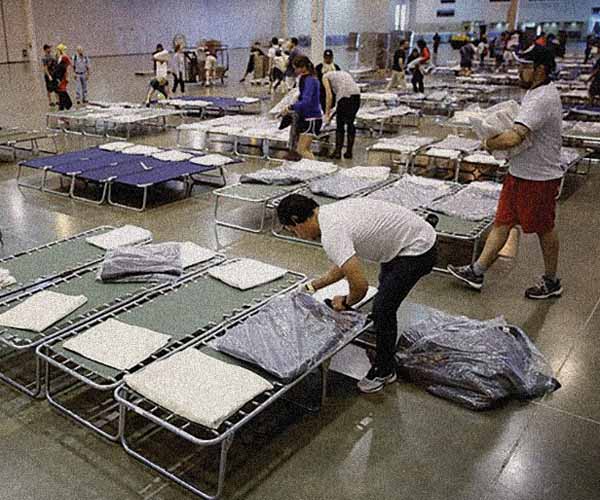
For Beaumont plastic surgeon Benjamin Beckert, MD, Hurricane Harvey could have been a lot worse.
After the August 2017 storm dumped a record 60 inches of rain in four days on the Gulf Coast region, there was some flooding in his solo practice, but it was less than a foot. While it destroyed some furniture and walls, it didn’t reach the valuable computers and servers. The hospital that owns the building repaired the office quickly and put him back in business within 10 days. He even had business interruption insurance to help smooth over some of the financial hit of closing down.
“We were able to return back to a functional practice in a fairly short period of time,” he said.
But functional doesn’t mean good. Dr. Beckert kept his staff members on salary throughout the closing, and all of them returned to work while their houses lay saturated with flood water. Most important, his patient base almost completely disappeared, and business took about six months to return to normal.
Dr. Beckert became one of 172 physicians and their 1,321 nonphysician staff members in 18 cities to receive help from the Texas Medical Association’s Disaster Relief Fund, an arm of The Physicians Benevolent Fund (PBF). It was set up in 2005 after thousands of displaced people came to Texas in the wake of Hurricane Katrina and to help physicians reestablish patient care after Hurricane Rita hit Texas later that year.
“The relief funds certainly helped to bridge the gap for the period of time when the office was closed and obviously into ramping it back up,” he said. “Not only did we lose the operational time that we were down and the repairs, we also lost a large number of patients. There was this community of people who were scheduled for surgery who just canceled and never returned.”
TMA’s response to Hurricane Harvey was the culmination of years of preparation that had started with those earlier hurricanes as well as Hurricane Ike in 2008, says Edinburg gastroenterologist Carlos Cardenas, MD, who was TMA president in 2017.
“We quickly put together a disaster relief committee made up of former TMA presidents to be able to garner funds, and we were able to raise [more than $800,000],” he said. That included $500,000 from The Physicians Foundation and generous gifts from other state medical societies.
Hurricane Harvey hit 41 counties in August 2017; by October the PBF Disaster Relief Fund began paying a record-high $792,390 to help physician practices recover, according to Gail Schatte, TMA’s associate vice president for trust fund administration.
Responding to Hurricane Harvey was an unprecedented effort because the storm affected more counties and cities than TMA had ever attempted to help before, she says.
“The need was so widespread, and it was all flooding related,” Ms. Schatte said. “Harvey was a flood, whereas the other [hurricanes] had roofs blown off. So, it was a totally different experience.”
But TMA did more than raise money and help physicians hurt by the flooding. TMA staff and county medical societies made it easier for physicians to volunteer their services, helped them overcome potential obstacles by private and government insurance, spread up-to-date news and information, and provided discounted consulting services to affected practices. In all, TMA staff and physician volunteers – not including the work done by the county medical societies – marshaled an unprecedented response worth an estimated $77,200, Ms. Schatte says.
“It’s not just the money we put out,” she said. “There’s a lot of time involved in organizing and putting things together.”

Hundreds of TMA members volunteered at medical shelters for people displaced by Hurricane Harvey, including shelters in Bexar, Dallas, Harris, and Travis counties.
In Harris County, where the flooding was most severe, members of the Harris County Medical Society (HCMS) set out to provide medical care at one of the county’s two largest shelters for displaced people, the NRG Center, a 700,000-square-foot exhibition space normally used for rodeos and auto shows.
Houston internist Lisa Ehrlich, MD, then HCMS president and now a TMA Board of Trustees member, became co-director of medical operations at NRG Center, and her first few days were especially difficult. Potential volunteer physicians and nurses were still coping with flood waters in their homes and neighborhoods, and there were very few medical supplies or medicines on hand.
“The triage the first couple of days was just trying to keep people from falling off a cliff,” she said.
Soon, though, the shelter – run largely by HCMS physicians along with volunteer nurses – provided 24-hour medical care in all specialties for a population of about 4,000 whose ages ran from 3 days old to 94 years old, Dr. Ehrlich said. HCMS physicians had always helped out in emergencies, but this was the first time they had been largely responsible for one emergency shelter.
Just as important, the NRG Center shelter provided first-rate medical care that many low-income people never see, Dr. Ehrlich recalled. Among other things, these patients had easy access to physical checkups, psychiatric treatment, dental exams, prescriptions, eye checkups, and glasses.
“It really showed you that there should be more collaboration [with other physicians and community resources],” she said. “We get siloed away, but come crisis time, we all work together.”
And working together to address the disaster paid off professionally in ways that might seem surprising, says Houston neurologist Kimberly Monday, MD, also a TMA board member and then HCMS’ immediate past president.
“Practicing medicine without the middleman? It was a blast,” said Dr. Monday, who helped set up medical services at the NRG Center. “To be able to go get the medicine and say, ‘We need this,’ and, ‘This person needs X,’ and not having to worry about the administrative business that we spend half our day doing. It was a delight to actually practice medicine in that environment where everybody was there for the same reason – the patients.”
Many Texas physicians and other health care professionals who were not affiliated with nonprofit organizations decided it was too risky to volunteer. That’s because the law at the time did not extend liability protection to them in such disaster circumstances.
In 2019, that resulted in Senate Bill 752, which TMA supported. It limited civil liability for volunteer health care professionals and the facilities that sponsor the care, assistance, or advice these volunteers provide – within their scope of practice – during a disaster. (See “TMA Resources,” page 48.)

In the storm’s immediate aftermath, though, physician efforts were geared toward coordinating patient care among different types of health care professionals, Dr. Cardenas says. Frequently, that meant meeting with medical organizations for nurses, dentists, and other health care professionals to find ways to coordinate services, he says.
“We’d learned from our previous experiences that we needed to have a variety of strategies to work on connecting patients to their physicians and prescriptions,” Dr. Cardenas said.
Those strategies also included working with the Centers for Medicare & Medicaid Services (CMS) as well as private health plans to obtain flexibility on things like claims deadlines and pharmacy refill requirements to help practices care for patients and rebuild, says Helen Kent Davis, TMA’s associate vice president of governmental affairs. TMA also advocated for federal and state waivers to allow out-of-state physician volunteers to provide services quickly, delay federal revalidation requirements so physicians participating in Medicare and Medicaid could maintain billing privileges, and postpone some performance deadlines for shared savings programs.
The response to Hurricane Harvey also led TMA and HCMS staff members to find creative ways to use technology, says John Dorman, TMA’s chief operating officer. For instance, TMA staff discovered that the Federal Emergency Management Agency (FEMA) database allowed TMA to tell if a particular address had been affected by the flooding. That let TMA better identify which physicians needed the most help from the PBF Disaster Relief Fund.
TMA also discovered FEMA had other helpful data the association could publicize, says Grant McInnes, TMA’s associate vice president of software engineering.
“It had all the shelters located in the [Gulf Coast] area that could be used to send people who had been dispersed by the hurricane,” he said. “We actually mapped all those data points and provided it as a resource on the TMA website.”

But often physicians needed something that just required long hours of work, and TMA and county medical society staff provided it. For example, HCMS’ staff found physicians to volunteer at the NRG Center and created the work schedule to make sure it was fully staffed around the clock.
The flooding shut down most of the region’s pharmacies in the days right after the storm, making it extremely difficult to obtain prescriptions or over-the-counter medicines, Dr. Ehrlich says. TMA staff spent long hours calling around to identify the relatively few pharmacies that were open so physicians could direct patients to them.
In the same vein, TMA referred physicians to vendors who could help them with water-damage clean-up, says Heather Bettridge, TMA’s associate vice president of practice management services. But often what practices needed the most was simple. For instance, practices that relied on electronic health records often needed paper forms to replace the electronic ones on their destroyed or powerless computers.
“We have templates for everything,” she said. “We ended up sending out a lot of those types of resources to people who couldn’t access what they already had.”
In many ways, Texas physicians appear to be better prepared than ever to respond to future disasters, Dr. Cardenas says. For one thing, TMA’s Disaster Relief Fund has now responded to three major disasters and has increased its fundraising and fund distributions each time. TMA also showed flexibility in responding to Hurricane Harvey. As physicians raised questions or problems, TMA moved quickly to address them and used improved communication technology to get the message out.
The HCMS experience at the NRG Center shows Texas physicians also have stepped up their response to disasters, with more physicians gaining valuable experience over time, Dr. Ehrlich says. For example, she was able to help provide medical services at NRG Center in part because of her experiences helping out during Hurricane Katrina.
“This wasn’t like reinventing the wheel, but it also wasn’t written down anywhere because [from disaster to disaster] you don’t know what your challenges are going to be,” she said. “But early on [in disaster response] physicians have to be involved, especially physicians with institutional knowledge."